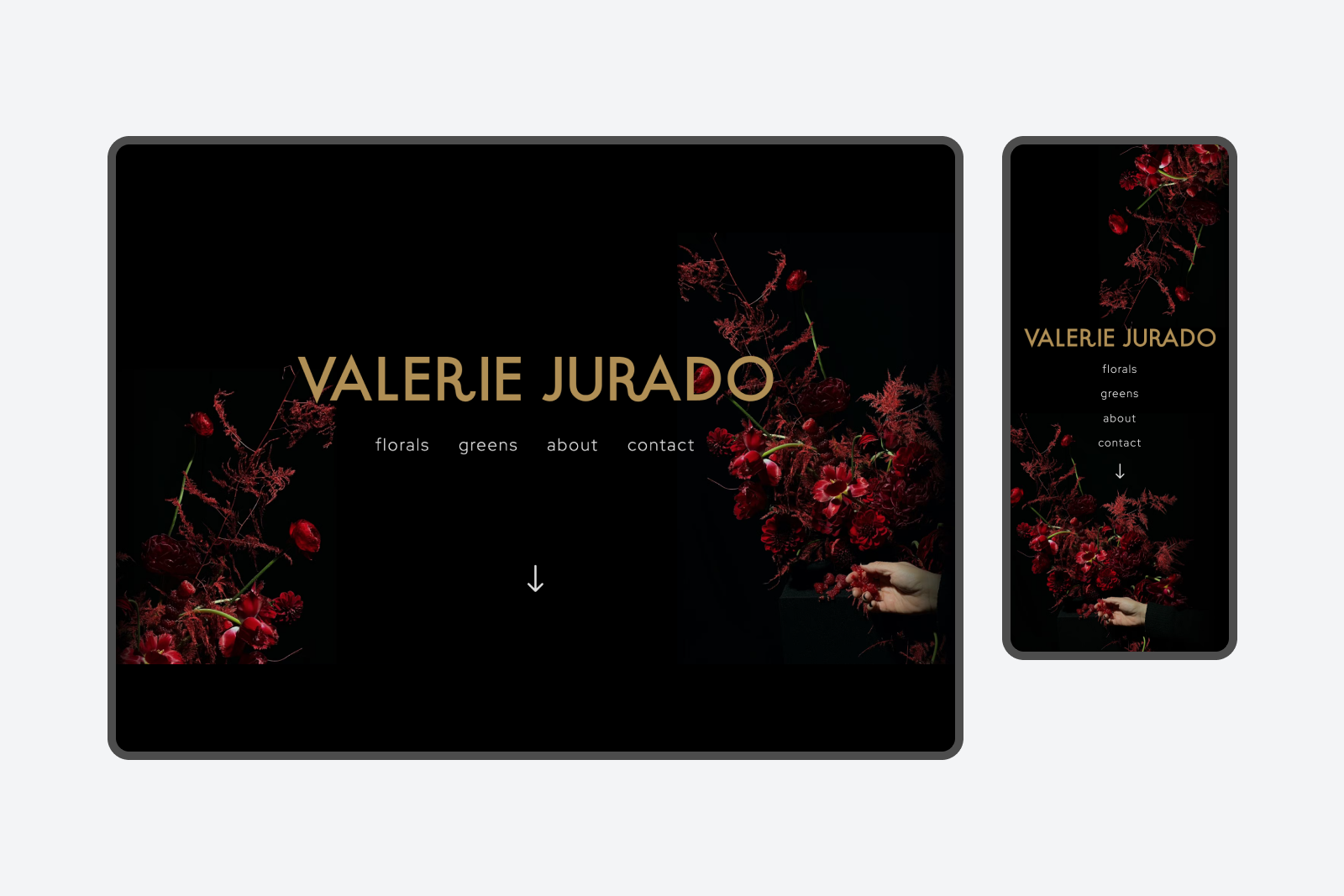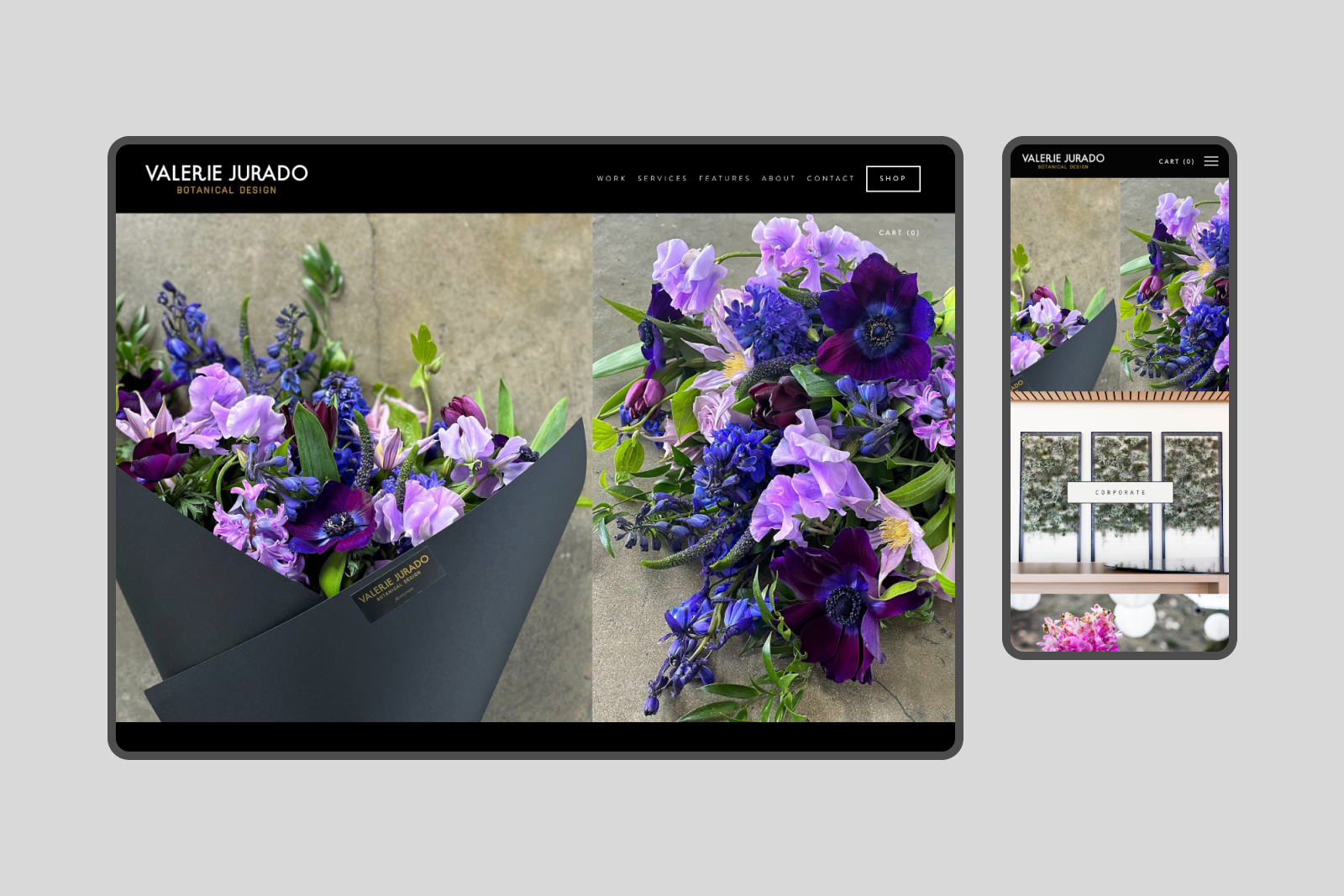Drove 7x increase in contact form conversions
for a high-end botanical designer
My role
- Aligned design direction with business
- Improved lead quality
- Built bespoke business site
Team
Product Design (me)
Founders • Marketing
Result
The Problem
Valerie Jurado needed a new website that converted visitors into qualified leads while reflecting her high-end, avant-garde aesthetic.
Valerie Jurado, a Los Angeles–based botanical designer, needed a new website that could better serve her business goals.
Valerie's original site was built in Squarespace in 2018. It was expensive, had low visual impact and was hard to update. Her business goals and clientele had changed since then. The site's contact form wasn't capturing viable leads and the photography didn't reflect the artistry in her work.
Valerie came to me to redesign and rebuild a website that showcased her brand's value, captured high-quality leads and supported her new business direction.


How might we
How might we create a website for a botanical designer that converts visitors into leads and showcases business value?
Setting goals
Aligning on Valerie's business goals
I set up a remote workshop with Valerie and her business partner, Allan, to define the goals and values guiding the website refresh. From that conversation, a few priorities emerged:
- Attracting the Right Audience The existing site was generating very few leads, and most were either spam or customers seeking casual floral services (weddings and Mother’s Day deliveries). Valerie wanted to attract high-end clients such as art galleries, fashion photographers, and luxury brands.
- Streamlined Engagement She wanted an easy way to direct people to her site, where they could quickly contact her or sign up for email newsletters.
- Defining a Unique Brand She wanted the brand to emphasize uniqueness and bespoke botanical experiences, rather than just weddings or events.

Valerie, Allan and I's Figjam workshop.
Roadmap and scope
After the workshop, I created a rough Now-Next-Later roadmap to define scope and keep the project on track.
I set the goal to launch the refreshed site within the year, with a plan to add new content quarterly and complete additional enhancements by the end of 2024.

The Now-Next-Later roadmap I created from our remote workshop.
Competitive research and identifying business values
A key part of this project was analyzing competitors in the high-end florist and botanical designer market. We observed that many luxury florists didn’t reference flowers or plants in their logo. The brand sounded more editorial and high fashion when we just used a name. We simplified Valerie's logo by removing ‘Botanical Design’ and used just ‘Valerie Jurado’.
Valerie's favorite designers emphasized minimal UI with large, striking photography. I knew her work photography was a major brand strength, so I designed the site with minimal typography, buttons and text. This let her business value take center stage.
What I did
I defined the site structure
I mapped out the site structure to support Valerie's business goals and new brand direction. We decided the homepage would be a long-form, Tumblr-inspired experience, with custom sections to showcase her projects. This would form the bulk of the design and development effort.
One of Valerie's business goals from our initial workshop was growing the ‘Greens’ portion of her business, where she designed and maintained living plant displays for her clients. This informed the decision to surface supporting pages like Greens and Floral early on the homepage with About and Contact.

The valeriejurado.com sitemap
I aligned business needs with technical solutions
A key business goal of the refresh was making the site easier for Valerie to update independently. I prioritized two capabilities when choosing platforms:
- Complete Customization I wanted to build a bespoke experience that didn't look like a template site.
- A Sustainable Solution I wanted Valerie to be able to update content without relying on me to write code.
I selected Prismic, a headless CMS that let me build custom-coded slices with HTML, Tailwind CSS, Next.js, and React. On Valerie's end, she could update text, switch images and rearrange the slices using a clean UI.

My view in VS Code, Valerie's view on Prismic UI and what the user sees in the end. Essentially a diagram of the headless CMS workflow.
I overhauled the contact form
I improved the user experience of the contact form by removing a bulk of the fields, minimizing what was required and simplifying the design. I added Mailchimp integrations so Valerie's leads were pulled directly into her mailing list audience when they filled out the contact form. In addition, I added a spam filter to improve lead quality.
I explored placing an opt-in form in the footer, however data from Mailchimp revealed that it was collecting mostly spam submissions. We decided to remove it and keep only the main form on the Contact page.
The new contact form flow with a Mailchimp spam filter.

I created a service blueprint to show the actions on the business and client side when a user sends a submission through the contact form.
I built the site
Once the design was finalized, I shifted into the development phase. I built the site using Next.js, React, Tailwind CSS and Prismic. To keep it flexible, I coded the content in modular sections that could be rearranged or reused to create new pages.
On the backend, I connected Prismic’s editor to the custom code, so any updates made in the CMS (like swapping photos, changing text, or reordering sections) instantly appeared on the live site. This setup gave Valerie the freedom to update her content independently while keeping the fully custom design we created.
Finally, I set up hosting on Vercel, connected Valerie’s existing domain and provided her team with a walkthrough of Prismic. I wanted to make sure they could confidently use the CMS to update content as her business evolved.
Results
On December 10, 2024, valeriejurado.com successfully launched with Vercel hosting. Migrating to cloud-based hosting reduced Valerie's annual hosting costs by 92% compared to the cost of her old Squarespace site.
When I measured post-launch metrics (measured 8 months before and after), I found a significant boost in engagement and over 7x more contact form conversions. I can confidently say I achieved Valerie's business goals we identified at the beginning of the project.
While my work on the contact form and site infrastructure made these improvements possible, the real strength of the site lies in Valerie and her team’s artistry. Their stunning photography and bespoke botanicals are really what give the website its lasting impact.